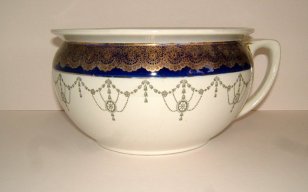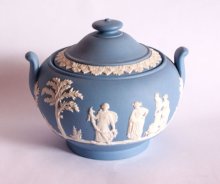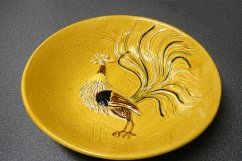Glass is a fascinating subject for some people, me included. I’ve always wondered who it was that first noticed that you can make a beautiful and fragile piece of glass from super-heated sand. Actually they have dated some of the earliest hollow glass pieces to 1500 B.C. (See here). I just find that incredible.

I happened to find this piece of Heisey glass and listed it in my store recently. I always research my pieces so this is where my research on this cruet led me.
Based on the mark, a capital H within a diamond, the piece was by A.H. Heisey & Company.
I found an amazing amount of information on Heisey at the National Heisey Glass Museum. According to the Museum, the founder of the company, Augustus H. Heisey, was born in 1842 in Germany but immigrated here with his family in 1843. He got into the glass business as a clerk at King Glass Company of Pittsburgh.

Shortly after that he enlisted in the Union army during the American Civil War, fighting for the North. He managed to survive his 3-year tour and exited the army as a Captain. He had a few jobs in different glass companies during which time he met his future wife, Susan Duncan, the daughter of the owner of Ripley Glass Company which was later changed to George Duncan & Sons.

As the Heisey Museum education page states, Augustus briefly tried mining out west but began plans while there for his own glass company. He opened Heisey Company in Newark, Ohio in 1896 with one 16-pot furnace.

The company grew to 3 furnaces eventually and employed over 700 people. His company was known around the world for their quality glass.
The diamond H trademark that can be seen here

was designed by Heisey’s son, George Duncan Heisey. His father was very proud of that design and had it registered and impressed on almost all their glass pieces. A number of pieces had a foil sticker with the trademark that, over the years may have become loose and fallen off, leaving the pieces unmarked. The quality of the glass will help to identify it as will the pattern.

Augustus Heisey died in 1922 and his son, E. Wilson Heisey took over the reins. He ushered in a period of colored glass that is highly collectible.

Colored glass went out of fashion by the 1940’s and then WWII curtailed the production of glass itself. By then T. Clarence Heisey was at the helm of the company. It was during his time that the very collectible Heisey figurines were created.

Unfortunately, as seems to be the story with so many old companies, the proliferation of foreign companies glutting the market with cheap glass put the Heisey company out of business. They closed for Christmas vacation in 1957 and never opened their doors again.
Definitely take time to visit the Heisey Museum website. They have videos and photographs of Heisey history and glass. It’s definitely worth the time to check it out!

I hope you have enjoyed learning a little about this great american glass company with me. If you get a chance, take a look around the Vintage Eve’s store for some great vintage glass pieces and leave me a note to say hi. Have a great New Year!





























